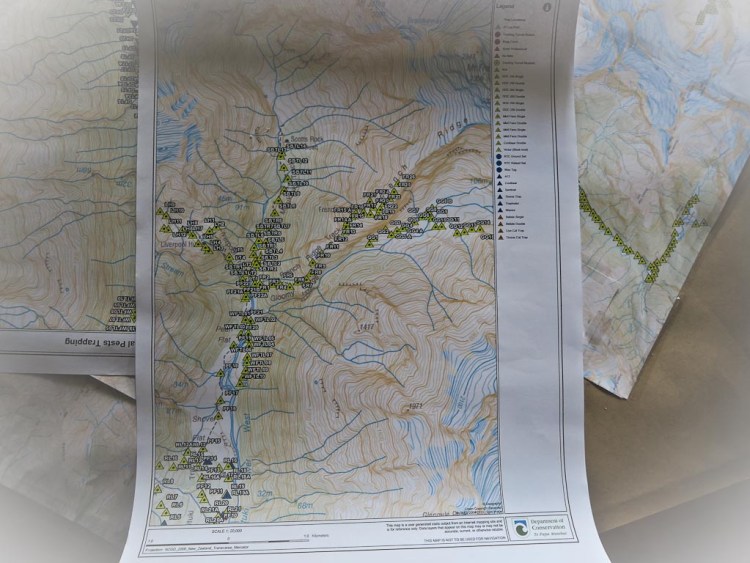top: Members of the Matukituki Trust planning trapping operations at Aspiring Hut 10 days ago
Many of you know that I’ve been involved with many others giving native bird populations a leg up via the Matukituki Trust for the last 4 or so years. Progress has been very steady and positive due a good base plan concept, followed up by proven methodology.
Taking a wider view the good news is that four Trusts inc. the Matukituki Trust, several landowners, tourism operators and DOC, are now working collectively in the area from the mid slopes of Mt Aspiring to Wanaka.


 Traps of all types upstream from Aspiring Hut in the West Matukituki valley, Mt Aspiring National Park. Liverpool valley on the left, upper west Matuki. and Scott Bivy rock in the center, and French Ridge on the right.
Traps of all types upstream from Aspiring Hut in the West Matukituki valley, Mt Aspiring National Park. Liverpool valley on the left, upper west Matuki. and Scott Bivy rock in the center, and French Ridge on the right.
[AdSense-B]
Many traps are above the winter snow-line in these three areas, with many being of the self resetting variety
I can’t comment yet on all the “kills” but in the last 6 months the Matukituki Trust’s traps have caught 911 predators: cats, rats, hedgehogs, stoats and possums. Mice, despite not directly being predators, are included.
It’s estimated that each predator kills 2 wildlife per week [birds, lizards,, bats insects etc] thus the above kills amount to 47,000 wildlife saved to-date.
Possums do eats chicks and eggs, but this aside 20 of them will eat 2 tons of vegetation per year, so this means that 18 tons are not eaten. That’s 9000 full shopping bags that stay on the trees to benefit the birds.
 A new kid on the block – one of many of the south island robin reintroduced some years back. Breeding has been so successful last spring that it’s hard estimate if we’re talking scores or hundreds of birds that have been bred by about 20.
A new kid on the block – one of many of the south island robin reintroduced some years back. Breeding has been so successful last spring that it’s hard estimate if we’re talking scores or hundreds of birds that have been bred by about 20.
In the last few weeks contractors have been in the valley to set up transects for annual bird counts, but so far exactly how many has not been released yet.
A brief history of the Matukituki Trust:
First we installed about 170 tracking tunnels in the West Matukituki valley to establish what predators were about that have been compromising bird breeding numbers. Answer: too many opossum and mice.
And on another front the means to scientifically establish how much seed the resident silver, red and mountain beech forest produced every three months. Answer: lots!
So-much-so, on both counts that the valley became “eligible” if you like for the Dept. of Conservation, partners with the Trust, to schedule a 1080 poison operation. This was carried out about 2 years ago. Interestingly I literally lived in the midst of it I
Knowing it’d be successful like in other areas like the Routeburn in “buying time” for more native birds chicks to reach maturity, work began in earnest on installing what now amounts to about 620 traps or various types in the valley [mostly high quality DOC 250’s], so that as the predator numbers inevitably increased, we’d be ready with other means to make sure the balance of bird v. vermin, swung in favour of the former.

Loving the positive outcome! It makes me so happy and hopeful 🙂 Amazing work everyone
Thanks Mathilde, keep up the good work yourself. Regrets re delay replying here, but over summer I’m up the valley 15 days at a time. All the best for 2017 Cheers
Donald xx